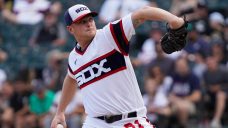CHICAGO — On Wednesday afternoon, as Toronto Blue Jays hitters stepped into the batting cage for their early work, a new scorecard system grading out their performances the night before awaited them. The concept isn’t exactly new, as they have been receiving swing-decision reports for a few seasons now, but the way they were being assessed was different. Justin Turner experienced something similar during his last five seasons with the Los Angeles Dodgers. The implementation of it by the Blue Jays is why he feels that “we're getting to a good point here,” in terms of game-planning and preparation. “The information and what we're rewarding guys for and applauding guys for is getting better.”
“The point system really evaluates the process of your at-bat, instead of the result of the at-bat,” says Turner. “It’s reinforcing the good things that we do and not necessarily harping on the negative stuff. There's some negative stuff in there. There's some situational-hitting stuff. Swinging at balls, you get docked. Striking out, you get docked. But fouling off a ball with two strikes, you get rewarded for extending the at-bat, giving you a chance to see another pitch, maybe get a mistake. Moving a runner, you get points for that. …
“You can go 0-for-4 and have a great day at the plate and this system tells you that. You’re swinging at strikes. You're hitting balls hard. You can't control where the guys are playing or if they’re making plays. But you can control what you're swinging at, you can control hitting balls hard. And if you do that over the course of 162, you're probably going to have a pretty good year.”
The scorecard is the latest in a series of adjustments the Blue Jays have made over the past three weeks to help right their offence and rescue a wayward season. Central is a shift in mindset, one manager John Schneider encapsulates as “taking more intentful swings in times that you can, and then drawing on the result of that as opposed to exactly what we swung at.”
That messaging began during the advance meeting heading into the May 10 series opener versus the Minnesota Twins. Though the Blue Jays lost 3-2 that night, afterwards players felt the way they attacked in the batter’s box boded well. Consider that through their first 37 games of the season, the team collectively batted .228/.308/.360 with 30 homers and 134 runs scored, an average of 3.62 per game. In the 18 games since that shift, they’re batting .252/.330/.410 with 19 homers and 86 runs, an average of 4.52.
Six games against the Chicago White Sox certainly helped skew the numbers, but even in low-output games against the Tampa Bay Rays and Baltimore Orioles, they’ve looked different than they did early in the season.
“It's pretty obvious if you've been watching us over the last few weeks,” says ace Kevin Gausman, “that there’s a change that's been made.”
Whether that’s enough for the Blue Jays to get on the type of run they need after a 26-29 opening is up for debate. But addressing the fundamental issues that have caused the offence to underperform dating back to last year is essential for the club, not only in the short-term but long-term as well, which is why the difference in what’s being emphasized and highlighted carries a wider significance.
The Blue Jays were among the game’s best offences in 2021 and 2022 and while personnel had something to do with that, the drop to 14th in the majors last year and 23rd so far this year is rooted, to some extent, in hitters not getting their best swing off often enough.
Schneider’s mention of intent is no accident, as it’s a word Blue Jays hitters are using to describe the thinking behind the types of swings they want to be taking, especially early in counts. Another way to look at it is trying to ensure hitters take their best swings at pitches in their hot zones early in counts, trusting in their contact skills to put balls in play with two strikes should they get there.
“I believe in taking chances until you get to two strikes and then when you get to two strikes, you battle,” says Bo Bichette. “We have a lot of really good two-strike hitters, guys that make good contact, so I think that's a great approach for us.”
The emphasis shift, says Schneider, was borne out of “looking at actual numbers to that part of the season,” and subsequent conversations between coaches and players to see what was important to them.
“You're always trying to draw from new ideas,” Schneider continues, “and whether it was something that (assistant hitting coach) Matt Hague did in the minors, or Justin Turner did with the Dodgers, or (third base coach) Carlos Febles saw with the Red Sox, you're always trying to evolve with how you're preparing, measuring and tracking… We talked about it as a staff first and then presented it as, 'hey, we're going to have a few different things to track, to go over, to cover, to react to,' listened to some feedback and then landed where we did.”
The resulting changes have made discussions on approaches and how to attack guys “a lot more productive,” says Turner. In adapting to the way each swing is judged, players expressed a sense of being freed up at the plate, helping them emerge from the passivity that marked the early part of the year to a more aggressive attack mode.
“The environment is more free, just in terms of being OK with making mistakes,” says Bichette. “We have three strikes to work with, so if we want to look for a fastball and they make us look dumb on a slider, as long as we're committed to the fastball, that's fine, get ready for the next pitch. The freedom to make mistakes, in a way, allows us to be better competitors.”
Provided of course that those mistakes are being made in the right way, a point Turner underlines.
There’s a crucial balance that needs to be struck between making smart swing decisions and being too careful, which can lead to passivity, and between being aggressive to an area and attacking the right pitches.
As Turner says often, it's better to be 0-1 than 0-for-1.
“We’re going to chase, but are we chasing in the right areas?” he explains. “If you do damage on balls closer to you and you keep chasing balls down and away, obviously there's something there that is a little bit of a flaw. Now, if you do damage closer to you and you're chasing a little bit in, or a little bit up, we can live with that because you know you do damage there. These are all conversations that are constantly happening. And it doesn't just happen overnight. You've got to keep going and keep working at it, keep talking about it, keep reinforcing it. And honestly, it has shown up a lot so far in May.”
The scorecard the Blue Jays posted results from Wednesday was based on Tuesday night’s 7-2 win over the White Sox. George Springer, who went 2-for-2 with three walks, led the team in points, says Turner, while Vladimir Guerrero Jr., who went 1-for-4 with a walk and put four balls in play at 96 m.p.h. or above, was fourth.
“George only swung at strikes and it’s like, well, duh – if you swing at strikes and take balls, you're probably going to have a good day,” says Turner. “And it doesn't necessarily mean you're going to have a good day results-wise, but you're probably going to have productive at-bats you're going to feel good about going back to the dugout. And it reinforces that.
“So far (the scorecard) has had pretty positive feedback from the guys. It's trying to weigh more of the good things, emphasize the good things we're doing and not punish you for having a terrible night.”
With more than enough of those at the plate for the Blue Jays since the beginning of 2023, it’s part of a course correction to an offensive approach and mindset that even after this winter’s recalibration, was in need of one.




























COMMENTS
When submitting content, please abide by our submission guidelines, and avoid posting profanity, personal attacks or harassment. Should you violate our submissions guidelines, we reserve the right to remove your comments and block your account. Sportsnet reserves the right to close a story’s comment section at any time.